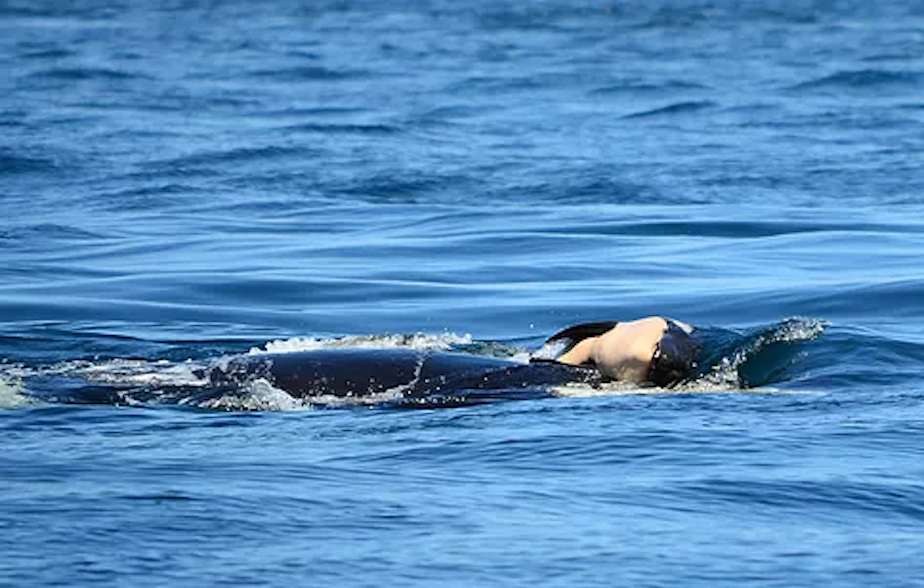The search for Scarlet the starving orca is over

And now, 6 tough questions about killer whale survival put to NOAA
The orcas of the Salish Sea are dying.
We first took notice when Granny, the matriarch, died in 2016 at the age of 105.
Newborn orcas were dying, too. This summer, the world tuned in as a mama killer whale carried her calf for 17 days, its body yellow and floppy. As each day passed, and she refused to let go, the number in the headlines ticked up – second day carrying her baby, third day, fourth – and humans on land became increasingly rattled. Her funeral procession became our protest.
Then came the news that the 3-year-old, nicknamed Scarlet or J-50, was in trouble. She was skinny, her head so narrow that she was dubbed a peanut head. Veterinarians, research and tribal vessels and choppers were dispatched to find her and treat her with antibiotics.
This week, officials determined that she, too, was likely dead.
The Center for Whale Research, which tracks the orcas in this region, issued a statement that read more like an obituary for the subspecies:
Watching J50 during the past three months is what extinction looks like when survival is threatened for all by food deprivation and lack of reproduction. Not only are the Southern Resident killer whales dying and unable to reproduce sufficiently, but also their scarce presence in the Salish Sea is an indication that adequate food is no longer available for them here, or along the coast.
On Sunday night, officials from National Oceanic and Atmospheric Administration took questions and comments from the public.
These whales need more chinook salmon. Why not reduce the harvest of chinook salmon?
When it comes to salmon harvest, salmon that start here migrate up to Alaska through Canada. Reducing harvest means you have to change a treaty that affects two or three states and two countries.
What would have happened if you HAD caught up to J-50?
NOAA scientists described how they would have done a medical exam on J50, and put her in a pool in Port Orchard if that’s what it took to save her.
But speaker after speaker said none of that would have put more salmon in the water for the whales to eat.
Erika Hansen put it this way: “I have no doubt that you love these animals. And while I appreciate that, it became clear to me last night that the bureaucracy of this organization is killing these whales as swiftly as the lack of salmon.”
Many said we need to sharply reduce the size of the chinook harvest, and breach dams on the lower Snake River.

Are there protected spaces for orcas?
There is an area, on the west side of Orcas Island, in the San Juans, where the government asks fishing vessels and cargo ships not to go because the whales like to hang out there.
But respecting that no-go zone is completely voluntary, and it's unlikely to be respected by fishers who have limited places where they can reliably catch fish.
But it's not like people who fish for salmon want to see them fished into extinction.
But fisherman Curtis Johnson said he wanted fishing shut down this year.
“Or as long as it takes,” he continued. “We need to do these things or these whales are gonna be gone. We don’t have any more time.”
That’s a decision in Washington Gov. Jay Inslee’s court.
What happens next time a whale is in trouble?
NOAA described the plan to rescue J-50: They’ll watch the whale, and if it gets separated, they’ll put it on a boat and do a medical examination.
Then, if they think they can help it, they’ll put it in a sea pen, or even in a giant pool above land, until they can stabilize it and set it free to rejoin its pod.
All the while taking care not to let it get dependent on humans.
Why are you calling on SeaWorld for advice?
People don’t trust SeaWorld because of the role they played decades ago in taking orca from Puget Sound.
And secondly, because the plan doesn’t resolve the core problem that there’s not enough salmon.
Michelle McClellan stepped up to speak. And she said that after watching J35 carry around her dead calf, she seriously considered going on a hunger strike.
“For two days, I was plagued with fantasy,” she said. “It got so far I thought if they drag me off to jail, which they probably will, I’m going to continue that hunger strike in prison.”
After the meeting, others came up to her to support the idea, and now she says she’s planning a relay hunger strike, where a succession of people fast for three days at a time until the dams on the lower snake river come down.
What about the tribes?
Ken Workman is a Duwamish tribal member and direct descendant of Chief Seattle. He referred to the Orca as people.
“There are people in that water,” he said. “There are salmon people, there are killer whale people. So I would implore you not to do the same thing to them that has been done to us.”
In other words – the Duwamish people failed to get federal recognition – and the protection that comes with that. And the killer whales are now going through the same thing, so he came to the meeting to give them a voice.
Workman says he’d like to see officials slow down boats. These big cargo ships come through with giant motors, which makes a phenomenal noise underwater. For animals that hunt by sound – that creates all kinds of problems.




